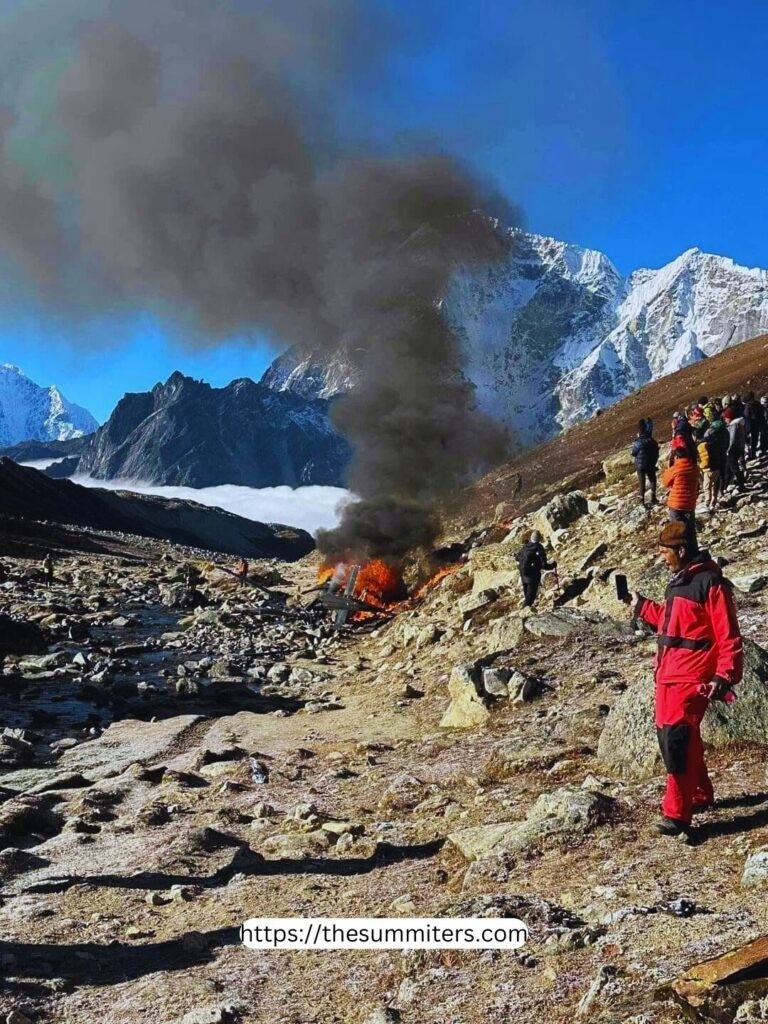One Saturday morning, a tragic incident occurred when a Manang Air helicopter heading to Solukhumbhu crashed in Lobuche. Gyanendra Bhul, a representative from the Civil Aviation Authority of Nepal (CAAN), reported that the helicopter, identified as 9N-ANJ, had taken off from Lukla at 7:13 am to collect passengers in Solukhumbhu. During its descent, the helicopter lost control and crashed, bursting into flames.

Read More: Everest Helicopter Crashed
Captain Prakash Kumar Sedhai Airlifted After Horrific Manang Air Helicopter Crash
The only person on board, Captain Prakash Kumar Sedhai, sustained injuries in the crash. He is currently being airlifted to the capital city on a Fishtail Air helicopter for medical treatment. The exact cause of the crash is still unknown, but it is doubt that the helicopter lost control mid-flight.
Fatal Echoes: Manang Air Helicopter Crash – A Harrowing Reminder of Risks in the Skies:
This tragic incident follows a similar one on July 11, where a Manang Air helicopter crashed in Lamjura of Likhupike Rural Municipality in Solukhumbu district. On that day, Captain Chet Bahadur Gurung and five Mexican nationals were aboard. The helicopter, with registration number 9N-AMV, lost contact in the morning and was later found crashed at Chihandanda of Lamjura, located between Jiri and Phaplu. It took rescuers five hours to locate the crash site, but unfortunately, all occupants had lost their lives.
Helicopter Crash Stats: Unveiling the Alarming Reality of Airborne Perils
The situations detailed in this context underscore the substantial risks confronted by both helicopter pilots and passengers, highlighting the immediate necessity for strict safety protocols and in-depth inquiries to avert such heart-rending incidents in the future.
Beyond the Flames
Understanding the Dynamics of Helicopter Accidents.
Helicopter accidents represent a notable safety concern, as indicated by the data discussed herein. These figures illuminate the prevalence of these accidents and their origins, encompassing elements such as pilot errors, mechanical malfunctions, adverse weather circumstances, and collisions.
Pilot Errors and Weather Woes
Challenges Loom Despite Safety Measures in Helicopter Travel Nepal’s Skies Weep: Helicopter Crashes Highlight Urgent Need for Stringent Safety Protocols.
These statistics serve as a potent reminder of the hazards linked with helicopter travel. For example the fatality rate of 1.3 deaths per 100,000 flight hours serves as a somber alert, underscoring that even with safety procedures in place, helicopter crashes can yield catastrophic consequences. In the United States alone, there are around 20 helicopter accidents per 100,000 flight hours, underscoring persistent risks despite safety precautions.
Navigating the Lingering Threats in Helicopter Journeys
Pilot errors, contributing to 33% of helicopter accidents, emphasize the paramount need for comprehensive pilot training. It communicates the imperative for pilots to undergo thorough training and stay cognizant of potential risks. Furthermore, mechanical failures, causing nearly 25% of incidents, stress the significance of regular maintenance and inspections to ensure helicopter safety.
Examining the Complex Causes Behind Helicopter Accidents
The introduction of Safety Management System (SMS) principles has led to a 50% reduction in helicopter accident rates in the United States, showcasing the positive impact of safety measures. Nevertheless, there were still 52 medical helicopter accidents documented between 2009 and 2020, highlighting the necessity for enhanced safety measures in medical helicopter operations.
From the Ashes: Helicopter Crash Statistics Paint a Sobering Picture of Air Travel Challenges
Additionally, incidents related to weather conditions and controlled flight into terrain (CFIT) events persist as notable contributors to fatal helicopter accidents. These statistics accentuate the importance of heightened awareness and precautions, particularly in adverse weather situations.
Conclusion:In conclusion, although technological advancements and pilot training have contributed to a reduction in helicopter accidents, these statistics underscore enduring challenges. Pilot errors, adverse weather occurrences, and other factors continue to pose substantial threats. Collaborative efforts among pilots, aircraft manufacturers, regulators, and other stakeholders are indispensable. Sustained vigilance and enhancements in safety protocols are imperative to prevent further fatalities arising from helicopter crashes.